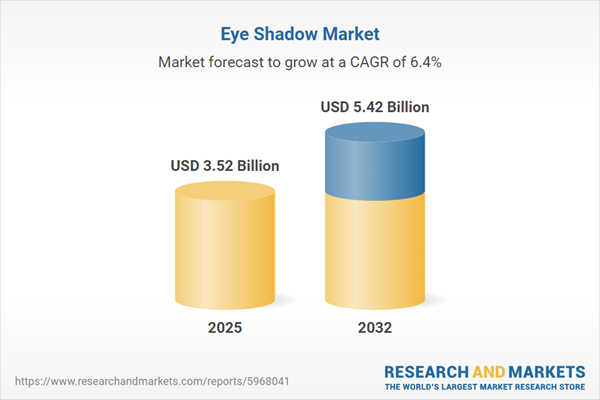Speak directly to the analyst to clarify any post sales queries you may have.
The global eye shadow market requires senior decision-makers to lead with digital agility, regulatory awareness, and a proactive stance on evolving consumer expectations. Staying competitive depends on continuous adaptation and a commitment to innovation within an increasingly complex landscape.
Eye Shadow Market Snapshot
The eye shadow market demonstrates steady, positive growth as consumer routines and product offerings steadily evolve. Market leaders leverage frequent product launches to retain consumer attention and use a blend of digital and in-person retail channels to maximize engagement. The application of advanced analytics enables timely identification of new buying patterns. This digital intelligence fosters swift adjustments in product and channel strategies, ensuring brands are responsive to shifting preferences. Multi-platform distribution remains essential for broad outreach, while integrated digital tools improve product design and sales alignment with customer needs. As the sector grows, brands that rapidly adopt technology and refine supply chain processes sustain their visibility and competitive edge.
Scope & Segmentation of the Eye Shadow Market
- Formulation Types: Cream, gel, liquid, pencil, and powder eye shadows—including pressed and loose variants—enable both daily use and artistic expression for diverse consumer groups.
- Finish Options: Matte, metallic, glitter, pearl, satin, shimmer, and bespoke finishes empower brands to remain flexible and appeal to evolving style demands worldwide.
- Distribution Channels: Department stores, specialty outlets, pharmacies, supermarkets, hypermarkets, convenience stores, branded e-commerce, and large-scale online retailers facilitate wide-reaching product access. This multichannel approach is particularly impactful for entry into emerging markets and maintaining presence in established regions.
- Price Segments: Luxury, mid-tier, and mass-market offerings accommodate varying spending power, supporting precise market positioning and differentiated branding.
- Regional Coverage: Coverage spans the Americas, Europe, Middle East & Africa, and Asia-Pacific. Each region presents unique consumer expectations, regulatory landscapes, and supply chain imperatives, requiring localized approaches.
- Key Competitors: Prominent innovators such as L'Oréal S.A., The Estée Lauder Companies Inc., Procter & Gamble Company, Coty Inc., Shiseido Company, Limited, LVMH Moët Hennessy Louis Vuitton SE, Revlon, Inc., Amorepacific Corporation, KOSÉ Corporation, and Kao Corporation drive strategic partnerships and product development efforts.
Understanding this segmentation sharpens portfolio development and channel targeting. Emphasizing sustainable sourcing and novel formulation methods enhances brand differentiation, while supply chain digitization advances compliance and supports sustainability goals.
Key Takeaways for Senior Decision-Makers
- Leveraging digital technologies, such as artificial intelligence and augmented reality, transforms customer engagement and reinforces seamless omnichannel strategies.
- Enhancing supply chain transparency and focusing on recyclable packaging solutions help brands achieve both regulatory compliance and operational goals.
- Localizing products and tailoring marketing initiatives facilitate stronger alignment with regional regulations and varying consumer priorities.
- Expanding color and finish selections, coupled with industry collaborations, supports rapid market responsiveness and broader customer inclusivity.
- Integrating technology into operations and focusing on agility equip brands to adapt efficiently to regulatory and market fluctuations globally.
- Strengthening supplier relationships and implementing nearshoring initiatives maintain high-quality standards and drive operational effectiveness worldwide.
Tariff Impact on Global Eye Shadow Supply
Upcoming U.S. tariffs on pigments and essential raw materials are projected to raise production costs and increase the intricacy of global supply chains. In response, organizations are prioritizing local sourcing, streamlining logistics, and seeking sustainable packaging alternatives. Heightened vertical integration is enabling companies to better manage regulatory unpredictability and uphold reliable product availability.
Methodology & Data Sources
The findings in this report are grounded in direct interviews with senior leaders in product development, supply chain, and marketing. Supplemented by proprietary corporate insights and up-to-date trade reviews, all information undergoes peer validation and triangulation to equip decision-makers with actionable, verified intelligence.
Why This Report Matters
- Sets practical benchmarks for product innovation, channel strategy, and operational improvement during periods of market transition.
- Identifies supply chain and regulatory risks to reinforce operational resilience and support steady business performance.
- Enables evidence-based portfolio expansion and targeted market entry, supporting growth while minimizing exposure to evolving industry challenges.
Conclusion
Effective competition in the eye shadow market depends on digital transformation, sustainable sourcing, and strategic collaborations. Leaders who prioritize proactive and adaptable strategies will successfully manage emerging complexities and maintain market relevance.
Additional Product Information:
- Purchase of this report includes 1 year online access with quarterly updates.
- This report can be updated on request. Please contact our Customer Experience team using the Ask a Question widget on our website.
Table of Contents
3. Executive Summary
4. Market Overview
7. Cumulative Impact of Artificial Intelligence 2025
Companies Mentioned
The companies profiled in this Eye Shadow market report include:- L'Oréal S.A.
- The Estée Lauder Companies Inc.
- Procter & Gamble Company
- Coty Inc.
- Shiseido Company, Limited
- LVMH Moët Hennessy Louis Vuitton SE
- Revlon, Inc.
- Amorepacific Corporation
- KOSÉ Corporation
- Kao Corporation
Table Information
| Report Attribute | Details |
|---|---|
| No. of Pages | 199 |
| Published | October 2025 |
| Forecast Period | 2025 - 2032 |
| Estimated Market Value ( USD | $ 3.52 Billion |
| Forecasted Market Value ( USD | $ 5.42 Billion |
| Compound Annual Growth Rate | 6.3% |
| Regions Covered | Global |
| No. of Companies Mentioned | 11 |









